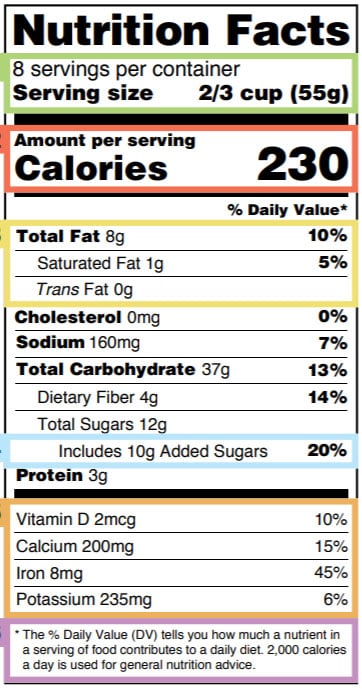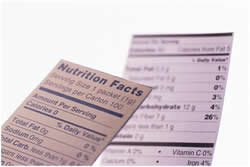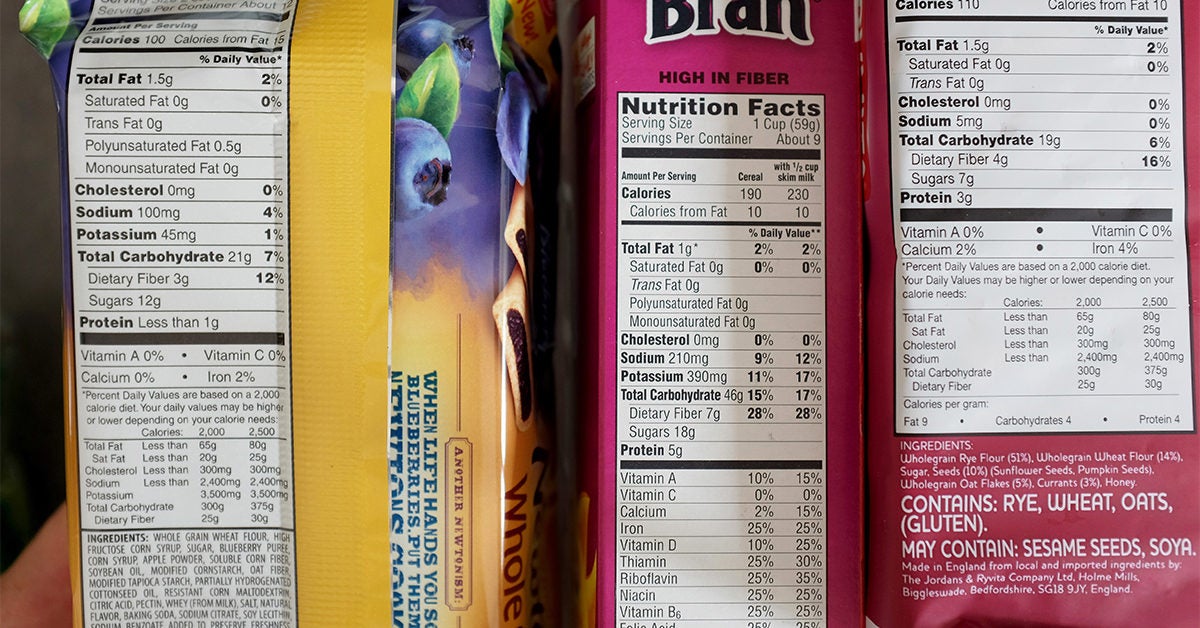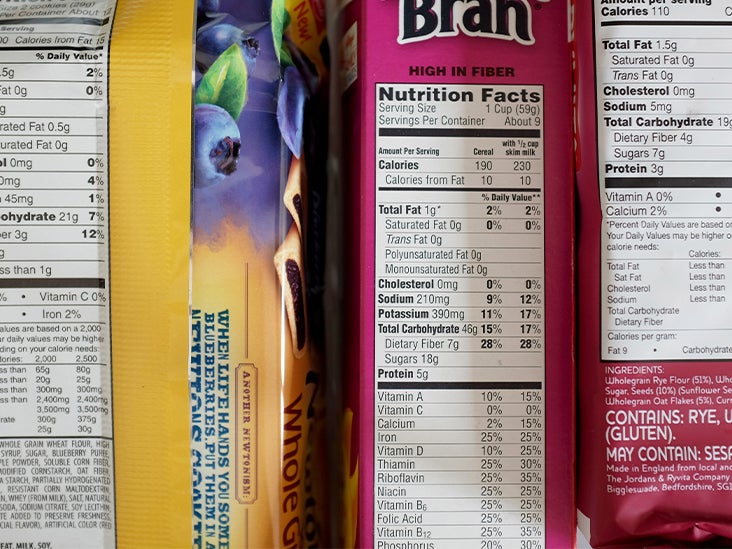45 reading food labels sugar
Reading food labels: Tips if you have diabetes - Mayo Clinic A sugar-free label means that one serving has less than 0.5 grams of sugar. When you're choosing between standard products and their sugar-free counterparts, compare the food labels. If the sugar-free product has noticeably fewer carbohydrates, the sugar-free product might be the better choice. Diabetes Food Label Reading: Quick Tips to Shop Smarter Stick to products that contain a maximum of 10 ingredients, 5 is even better. It's also good to understand that anything labeled "sugar free" can technically still have up to 0.5 grams of sugar per serving, so it's not always as straightforward as it seems. "Sugar free" and "no added sugar" does not mean carb free.
How To Read Food labels for Sugar | My Sugar Free Kitchen Generally anything over 5grams or ml of sugar (either per serving or per 100) is considered to be "added" as opposed to naturally occurring. If you're not sure how many calories you're consuming, check out myfitness pal. It will help you to track your calorie intake. Input your food for 1 week to get and average of how many calories you are eating.

Reading food labels sugar
Food labels - NHS Some front-of-pack nutrition labels use red, amber and green colour coding. Colour-coded nutritional information tells you at a glance if the food has high, medium or low amounts of fat, saturated fat, sugars and salt: red means high amber means medium green means low In short, the more green on the label, the healthier the choice. Sneaky Sugars: How to read food labels - Natvia The tricky part comes when you realise that this counts ALL sugars - added sugars as well as those that naturally occur in food, such as fruit. This means that a product that claims to be 'no added sugars' can still be high in its overall sugar content. Sneaky! Dietary fibre: You won't see this on all food labels. It only needs to be ... safefood | How to read food labels Some labels use colour coding to show at a glance if a food is high, medium or low in fat, saturated fat, sugar and salt. Low (green) - the best choice. Medium (amber) - okay most of the time. High (red) - only choose occasionally. If the label isn't colour coded, use our label decoder as a guide. Low (green)
Reading food labels sugar. Sugars on food labels - Sugar Nutrition Resource Centre Sugars on food labels Carbohydrates are broadly classified into monosaccharides, disaccharides and polysaccharides FIND OUT MORE Monosaccharides and disaccharides are otherwise known as 'sugars' FIND OUT MORE Polys or sugar alcohols are naturally found in some fruits and used commercially in products such as chewing gum FIND OUT MORE How to Read Food Labels Without Being Tricked - Healthline Other added sugars: barley malt, molasses, cane juice crystals, lactose, corn sweetener, crystalline fructose, dextran, malt powder, ethyl maltol, fructose, fruit juice concentrate, galactose,... How to Read a Food Label to Make Sure It's Keto in 3 Easy Steps Bacon is a great example because it's hard to find bacon that doesn't have sugar listed as one of its first 5 ingredients. And because… bacon. 3 no-sugar bacon options 1. Look for a brand that indicates "No Sugar Added". Read the ingredient list to verify. Pederson's brand with the No Sugar-Whole30 Approved seal is my personal choice. 2. How to Understand and Use the Nutrition Facts Label | FDA Single-Ingredient Sugar labels Packages and containers of products such as pure honey, pure maple syrup, or packages of pure sugar are not required to include a declaration of the number of grams...
Reading Food Labels? 5 Ingredients To Avoid Giving Your Children Sugar is obviously found in sweet foods. But you can also find it added to pasta sauces, marinades and dressings. So it's important to be reading food labels to see which everyday foods contain added sugar. But when it comes to reading food labels, spotting sugar can be tricky. There are over 40 different names for sugar on an ingredient list! LABEL READING: CARBOHYDRATES AND SUGARS - Renaissance Nutrition Center ... At this point, you cannot tell how much sugar the manufacturer has added; when the food labels change in 2018, there will be a line named "added sugars." One teaspoon of sugar or sugar equivalent is 4 grams of sugar, 16 calories. Products we call sugars are often included in Total Carbohydrates, but not in the Sugars listings. Added Sugars on the New Nutrition Facts Label | FDA Let the Nutrition Facts Label Be Your Guide The new Nutrition Facts label can help you compare and choose foods that are lower in added sugars. Check the label to see if foods are LOW or HIGH in... Food Labels | CDC If you eat the whole thing, you are eating 8 times the amount of calories, carbs, fat, etc., shown on the label. Total Carbohydrate shows you types of carbs in the food, including sugar and fiber. Choose foods with more fiber, vitamins, and minerals. Choose foods with lower calories, saturated fat, sodium, and added sugars. Avoid trans fat.
Learning To Read Labels :: Diabetes Education Online When you read food labels, the grams of sugar are already included in the total carbohydrate amount, so you do not need to count this sugar amount separately. The grams of sugar listed include both natural sugars, from fruit or milk, and added sugars. On a nutrition food label, the total carbohydrate includes the sugar. Food label reading guide | Nutrition Australia Most food or drink packages have a Nutrition Information Panel (NIP) which tells you the quantity of various nutrients a product contains per serve and per 100g or 100 ml. The NIP will also provide information on the serve size and the number of servings per packet. When reading the NIP: • always read the per 100g column to compare similar ... Reading labels | Diabetes UK Key points. Always look at the 'total carbohydrate' on the label when carb counting. This will make sure you are counting both the complex (starchy) and simple (sugary) carbs in your food. Both will raise your blood glucose (blood sugar) levels, and need to be matched with insulin. How to understand food labels - Eat For Health Sometimes labels will include nutrition content claims like 'low fat', 'reduced salt' or 'high fibre'. These claims can only be used if the food meets certain criteria. For example, with a 'good source of calcium' claim, the food must contain more than a set amount of calcium. While nutrition content claims can generally guide ...
Understanding food labels - Diabetes UK The labels show how many calories are in the food or drink and are also colour coded to show whether the food is low (green), medium (amber) or high (red) in fat, saturated fat, sugar and salt. The information on the front of the pack also tells you how the portion of the food contributes to the Reference Intake (RI) of an adult.

The 61 names of sugar – Read the food labels for hidden sugar | Food labels, Reading food labels ...
Reading Food Labels When You Have Diabetes - WebMD It has measurements of fat, cholesterol, sodium, carbohydrates, protein, vitamins, and minerals for a typical amount of that food. This information can make it easier for you to choose foods that...
How to Read a Label - Natural Sugar versus Added Sugar Locate the *Ingredients* list on the food label. Trick is to differentiate between ingredients that add sugar (high fructose corn syrup or sucrose) and ingredients that have natural sugar that is inherent in the raw or base food. A can of HUNTS TOMATOES will show grams of sugar on the label even though it only contains only tomatoes because ...
Understanding food labels - Action on Sugar Drinks high in sugars have more than 11.25g / 100ml OR more than 13.5g sugars / portion. HOW MUCH SUGAR IS IN YOUR FOOD/DRINK? Step 1 - Calculate amount of sugars per gram by dividing the amount of sugars per 100g OR 100ml by 100. Step 2 - Check the weight of a recommended portion as stated on the pack. Step 3 - Work out the amount of ...
Understanding sugar content on food labels - Diabetes Care Community Understanding sugar content on food labels is important, to ensure that you're consuming healthy amounts. Reading the ingredient lists and nutrition facts tables on packaged foods is a helpful way for you to check what kind, and how much, sugar a product has. Finding sugar content in the ingredients list
How To Read Food and Beverage Labels - National Institute on Aging For more information about food labels USDA MyPlate 703-305-2060 U.S. Department of Health and Human Services 877-696-6775 U.S. Food and Drug Administration 888-463-6332 druginfo@fda.hhs.gov This content is provided by the NIH National Institute on Aging (NIA).

The 61 names of sugar – Read the food labels for hidden sugar | Food labels, Reading food labels ...
Understanding food labels - Diabetes Ireland Understanding food labels. Food labels give us details such as the weight of the item and the best-before-date. Most will also provide all or some of the following: All the ingredients are listed in order of their descending weight, this means that the food contains more of the ingredients listed first; and less of those listed last. For ...
5 ways to spot added sugars on food labels - Tryon Medical Partners When reading the food labels, remember four grams of sugar is equal to one teaspoon. The American Heart Association recommends women consume no more than six teaspoons and men no more than nine teaspoons of sugar per day. 5. Read the label top to bottom Items on food labels are listed in order from largest to smallest quantity.
Reading Food Labels | ADA - American Diabetes Association The Nutrition Facts labels on foods are really the key to making the best choices. We'll cover the basics so that these labels make shopping easier for you. Get started Understanding Carbs You've heard it all. From carb-free to low-carb, to whole and empty carbs, it's hard to know what it all means. Learn more Food & Blood Sugar
How to read labels for added sugar - That Sugar Movement Words such as 'sugar', 'syrup', 'juice', 'concentrate' or even 'crystals' one should be wary of. Words ending in '-ose' like glucose, fructose, dextrose or sucrose that are listed on a label are added sugars. Note: if they are naturally occurring, like glucose in whole fruit, it won't be listed as an ingredient.
safefood | How to read food labels Some labels use colour coding to show at a glance if a food is high, medium or low in fat, saturated fat, sugar and salt. Low (green) - the best choice. Medium (amber) - okay most of the time. High (red) - only choose occasionally. If the label isn't colour coded, use our label decoder as a guide. Low (green)
Sneaky Sugars: How to read food labels - Natvia The tricky part comes when you realise that this counts ALL sugars - added sugars as well as those that naturally occur in food, such as fruit. This means that a product that claims to be 'no added sugars' can still be high in its overall sugar content. Sneaky! Dietary fibre: You won't see this on all food labels. It only needs to be ...
Food labels - NHS Some front-of-pack nutrition labels use red, amber and green colour coding. Colour-coded nutritional information tells you at a glance if the food has high, medium or low amounts of fat, saturated fat, sugars and salt: red means high amber means medium green means low In short, the more green on the label, the healthier the choice.










Post a Comment for "45 reading food labels sugar"